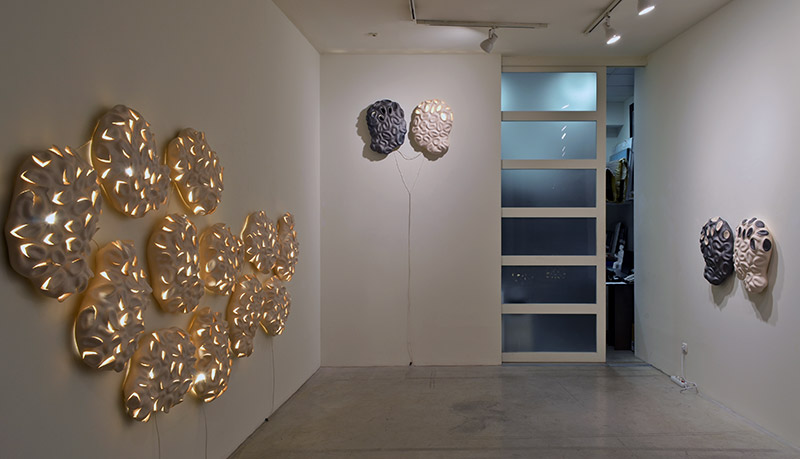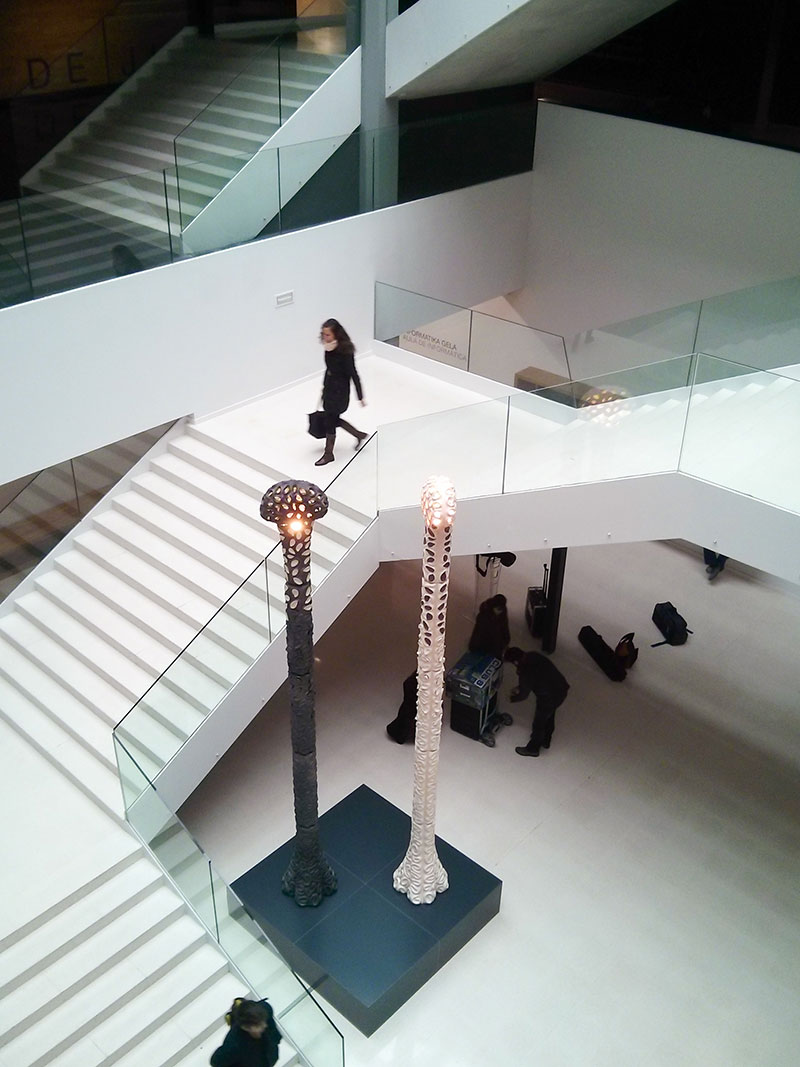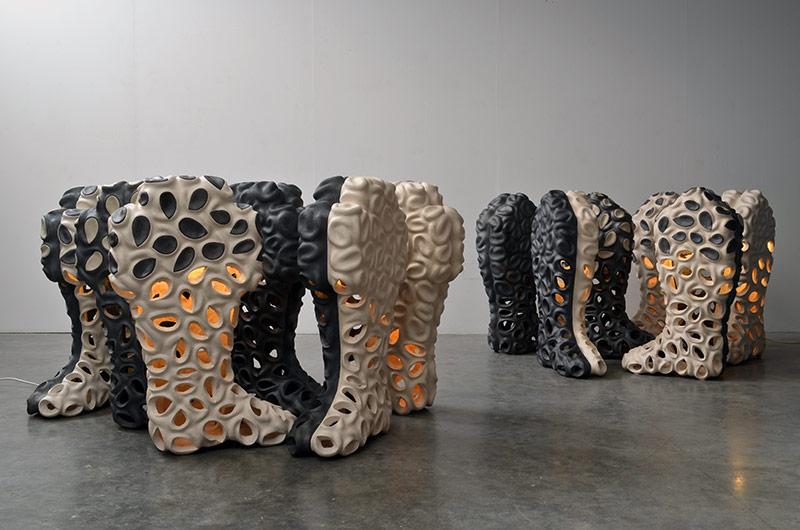ILLUMINATED INTERIORS

The series illuminated Interiors, was actively produced from 2005 to 2013, with the exception of a pause from 2009 to 2011; two years in which the work produced should be included in the series: Things & Causes (2008-2014). These two periods can be seen as two sides to the same coin.
The series illuminated Interiors began to develop in 2005, the same year that the previous series, Going Over Memories concluded. Despite the fact that Going Over Memories has reached its conclusion, the connection between work, series and entirety are enormously complex. A series which can now be identified with a certain clarity, is not seen in the same way as in the moment it began its journey. In its first stages there was no certainty as to whether a work was immersed in one series or another. At that precise moment the only thing one knows is that one is trying to do something, achieve something, as always happens, without a previously established goal. The work constitutes a series once it finds itself in an advanced stage of development.
In this state of uncertainty, of cloudiness, there are times when some works could belong to one series or the other. Even in the post-analysis doubts appear and one perceives possible contradictions that however, when considering the entire completed work, weaken and disappear, given that the whole takes on a definitive fullness of meaning. Certain works remain difficult to place, so, for example, a group of early works (fruits of the smoke ) have been included that could have been left out or placed in another series. But finally it was considered appropriate to place them here because they function as a transition between series and serve as necessary preliminary steps that sketch, define and focus on fundamental questions about the series itself.
In the first period of the series I created a major part of the work destined for the solo exhibition entitled, fruits of the smoke, installed in the Sala Luzán de Zaragoza, in May 2008. In these early works, I deal with both the internal premises that the series itself proposes and also the possibilities that the exhibition space offers. The space was ample, unobstructed, with no columns and fairly low ceilings which permits the use of the surrounding wall as a staging for various pieces in a horizontal mural format of considerable dimensions. Secondly, a free standing assemblage arranged on the floor of the space allowed the viewer to visually address it in its entirety. A framework of relationships was established between the elements of the installation, referring to the intriguing confrontation of "foreground and background". Besides these pieces, the exhibition included a number of works from the previous series Caleidoscopias, (Kaleidoscopes).

Sala Luzán, Zaragoza. 2008.

Illuminated interiors, 2012. Grog stoneware. 56 cm. height.
Both the wall piece and the free standing work manifest tactile subtlety, besides having a considerable formal strength. These behave, in relation to the ensemble, as fragments of the whole. No one particular focal point is suggested and all the elements form a visual journey. The articulation of some subtlety repeated surfaces, enveloping the pieces softens the distinctiveness of each piece and invites the viewer to move from one image to another continuously, in an interdependent almost automatic exercise.
As the series advances, and perhaps as an answer to this hermeticism that the work implies, in the studio I experimented with ripping the clay, making timid cuts, small slits, subtle cavities, trying to enter into the interior of the forms. As these openings became more frequent and the pieces became lighter as a result of the loss of mass, the works began to show this intuitively sensed interior, an invitation to investigate, to uncover, and ultimately, to provoke the necessary willingness of the viewer to enter the internal space of the work.
It is at this moment, that the series acquired its true identity, and the title that will identify it takes on its true force: Illuminated Interiors. It was during this time that lighting devices were first introduced that illuminate the interior, strengthening its fundamental meaning.
(...). This series, similar to previous ones, develops over time from an initial, fairly vague idea in regard to its formal characteristics. As it gains consistency and we construct the diverse elements that we use, it serves as an excuse or catalyst to advance in the project. In this case, the use of light in the interior of the pieces, and which we generically refer to as "illuminated interiors". 48

Illuminated interiors, 2011. Grog stoneware, wood, glass and light bulbs. 93 cm. height.
With this strategy I turned the subject on its head and continued developing proposals that, without greatly altering their structural and material qualities, have given the work a new dimension which has allowed me to delve into its very essence from a praxis that offers new challenges.
The first of these proposals I developed responding to an invitation to intercede in the Centre Cèramique Contemporaine of La Borne (France) in the year 2011. The exhibition space is of considerable size and the possibility to create a site specific work was considered. I proposed an activation not only of the floor area but including the extreme height of the ceiling and the verticality of the room.
In some previous works, the need arose to break through, perforate, the surface of the material with the intention of showing the hidden part of these totally hermetic objects, sealed, that emerge from the very procedural methodology of my work. Penetrating in its interior, uncovering these primordial gestures, vital and constructive, making them more accessible. Perhaps like a metaphor for confining ourselves in our own interior and realizing that deep down, the sentiments are like these illuminated interiors, universal in their internal finish, though their exterior appearance are as diverse as our own individuality.
In this series, that at first I define as "illuminated interiors", I again consider this subject, developing a continuation of answers, that stem from the work "winter, spring, summer and autumn", exhibited for the first time last year in the Centro La Borne (France) and where light is an essential part of the same. A way of shedding light on this contradiction, between the collective and the individual (interior/ exterior) and referring in some way to what goes on around us and in our own lives, in essence the search that illuminates and reveals this contradiction. (...) 49
The work (...) symbolically represents, through its distribution in the space, a reference to a small wood, which we pass through in an attempted journey through our memories. (...) 50

Centre Cèramique Contemporaine, La Borne (Francia) 2011.
I made a proposal based on eight pieces, four and a half metres in height, positioned so as to activate the entire exhibition space simply by their presence. The pieces, with a marked vertical character, allowed me to completely fill the space, as much by the intensity of the work as by its size. At the same time the light emitted from the top of each figure activated the ceiling in an evocative and intriguing way, below which the visitors could pass between the pieces.
This same work was installed again the following year (2012) in the Sala Enrique Cook in Muel-Zaragoza, for the exhibition organized by the County Council of Zaragoza, a proposal entitled: Ángel Garraza, Maestros de la cerámica y sus escuelas. Presenting a comprehensive survey of my work in dialogue with the work of ten former students of mine; the exhibition was a symbolic representation of the many students that over a long teaching career, I have had the pleasurable task of accompanying in their artistic education.
Out of this project new approaches arose that offered me the possibility of tackling works that posed diverse questions, but always from the context of the incorporation of light as the communicative link, and all of them under the same title: Illuminated interiors.

Illuminated interiors, 2012. Grog stoneware. Variable dimensions.

Espacio Marzana, Bilbao. 2012.
Finally, and as a conclusion to this series, the opportunity was presented to me to realize an intervention in the space planned for the central staircase of the Central Library of the Leioa Campus, part of the University of the Basque Country/ Euskal Herriko Unibertsitatea, a development designed by the architects FIARK.
The proposal entitled: Barrualde argiztatuak (Illuminated Interiors) developed within the framework of a project that aimed to find links between the first Basque University, inaugurated in 1936 and closed after only one year by the Spanish Civil War conflict and the present University of the Basque Country.
The work is composed of two pieces made in stoneware (smoke fired black and white stoneware) five metres high. Through the changing colour and surface relationships established between the two vertical elements, the transition of the four seasons is described.
Starting at the base (winter), a form arises in the form of a Greek cross and suggests the roots in which the vertical structure is anchored, and in a certain way evokes a tree, rising in a cylindrical structure that journeys through the different seasons of the year, as a symbol of the time necessary for ideas to bear fruit.
Finally, and by perforating the material in the upper part, light is emitted from the interior that describes the two containing volumes which, symbolically represent illuminated brains. The two structures reflect on two different moments, two historic times and the light evokes the fundamental labor of the institution as a lighthouse of knowledge.

Central Library, University of the Basque Country. 2013.
All of the works in this series use production methods associated with the modeling process of construction. Sometimes using internal molds to which a layer of clay is applied, once modelled they are cut into many fragments, which after firing are pieced together on a support that consolidates them and permits their subsequent installation. In other series the process is carried out with the help of molds taken from prototypes. Once removed from the molds the pieces are manipulated during the multiple phases of the process with the aim of obtaining variation within the series.
The materials used in the majority of the works are clays based on stoneware, mixed with grogs of diverse characteristics and of various grading, depending on the type, complexity and size of each proposal.
In the same way, the firing is carried out using kiln techniques such as oxidation for the clear tones and smoke firing for blackish or metallic ones.
I prefer to fire at temperatures that do not imply added difficulties that the very medium itself already has. Obviously I renounce certain qualities that extreme temperatures offer, and which I value, but in this, as in everything, you have to situate yourself in the terrain that most suits your work.
Another question is that of the possible treatments of the surface. A long time ago I ceased to alter the materiality of the objects. The material is what speaks, constructs the interior and shows itself in the surface. There is no added colour. One the one hand the clay, the material, and on the other the smoke that darkens it. 51

Illuminated interiors, 2012-2013. Grog stoneware. 93 cm. height. (12 pieces).
48 "Loca Amoena" (catalog). Bizkaia Aretoa, Bilbao. pp. 6-15. 2013.
49 "Ángel Garraza. La luce, la terra e il fuoco". Laceramica (specialized magazine). Milán (Italia). pp. 3, 36-41. 2012.
50 "Loca Amoena" (catalog). Bizkaia Aretoa, Bilbao. pp. 6-15. 2013.
51 "Ángel Garraza". Terrart nº 40 (specialized magazine). Barcelona. pp. 5, 20-24. 2012.
